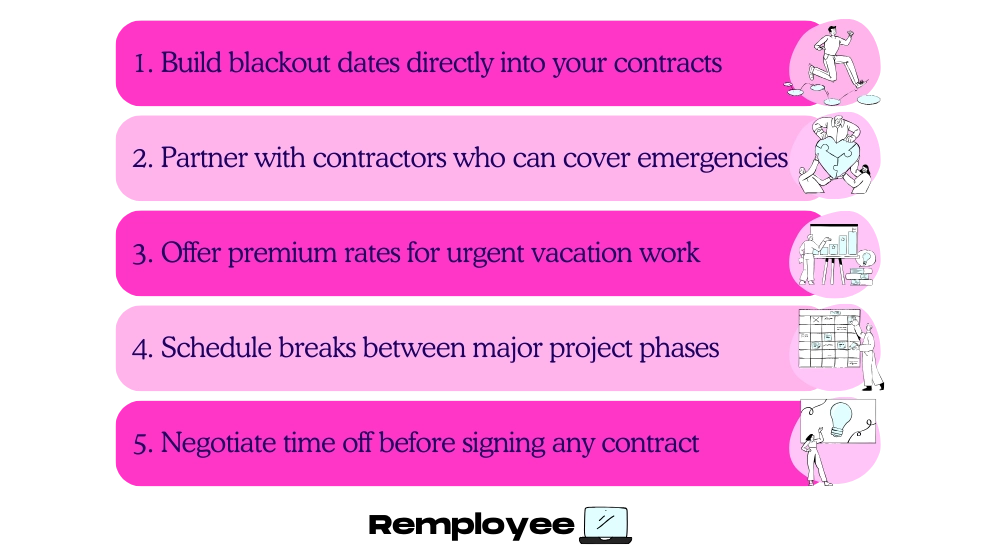No, contractors typically don’t get paid time off – you get paid only for hours worked. This fundamental difference between contractor and employee status affects millions of professionals navigating the gig economy.
You might earn higher hourly rates as a contractor, but every vacation day, sick day, and personal appointment comes directly out of your pocket. Smart contractors build time-off costs into their rates and create their own safety nets.
Here are five things to know, so you can make informed decisions about contract work and negotiate better terms.
1. What PTO Means and Why it Matters?
Paid time off encompasses vacation days, sick leave, personal days, and holidays where you continue receiving your regular income. According to the Bureau of Labor Statistics, 79% of private industry workers had access to paid vacation in 2025, making PTO a standard employee benefit across most industries.
You accrue these days based on tenure and company policy—typically starting with 10-15 days annually. PTO serves a dual purpose: protecting your financial stability during breaks and preventing burnout. Companies budget PTO as part of total compensation, calculating it into their annual labor costs.
For employees, PTO represents roughly 4-8% of total compensation value. This safety net lets you recharge, handle emergencies, and maintain work-life balance while keeping your bills paid.
2. Do Independent Contractors Qualify for PTO?
Independent contractors don’t qualify for paid time off under federal law. You operate as a separate business entity, meaning companies pay you for deliverables or hours worked—nothing more.
This exclusion from PTO stems from your classification:
- You control your schedule and work methods
- You invoice for completed work, not time
- You manage multiple clients simultaneously
- You handle your own taxes and benefits
- You set your rates to cover downtime
Some states like California have pushed boundaries with AB5, but PTO remains firmly in employee territory. Courts consistently rule that providing PTO to contractors risks misclassification lawsuits.
Your contract might include project deadlines and availability requirements, but paid leave stays off the table. This reality shapes every aspect of contractor financial planning.
3.The Difference Between Employees and Contractors
The distinction between employees and contractors goes beyond paychecks—it fundamentally changes your relationship with work and benefits.
This classification affects everything from tax obligations to legal rights. Misclassification can trigger severe penalties for companies, which explains their strict adherence to these boundaries.
4. Alternatives to PTO for Contractors
Smart contractors create their own time-off strategies that mirror traditional PTO benefits.
Many successful contractors combine multiple approaches. You might pad your hourly rate by $20-30 to fund vacation days while simultaneously building a course that sells while you sleep.
Retainer agreements offer the closest thing to traditional employment stability—clients pay a fixed monthly amount for your availability, giving you predictable income even during slower periods.
5. Tips for Negotiating Time Off as a Contractor

Start time-off negotiations before signing any contract. You hold maximum leverage during initial discussions, when clients need your expertise most.
Frame time off as project scheduling rather than requesting permission—you’re informing clients about your availability, not asking for favors.
Build blackout dates into contracts for planned vacations, family events, or industry conferences. Offer clients first right of refusal for urgent work during your time off at premium rates (typically 1.5-2x normal).
Create coverage partnerships with other contractors who can handle emergencies, maintaining client confidence while you’re away.
Schedule contracts with natural breaks between project phases, allowing guilt-free downtime and less work fatigue. Communicate your time-off policy upfront in every proposal—professionals who value work-life balance attract clients who respect boundaries.
Taking breaks makes you more valuable, not less reliable.
Wrapping Up
Contractors trade traditional PTO for higher rates and flexibility—a conscious choice that demands strategic planning. You control your time off by building it into your business model from day one. Calculate your true costs, pad your rates accordingly, and communicate boundaries clearly with every client.
The contractors who thrive understand this trade-off and plan for it. Your success depends on treating time off as a business expense, not a luxury. Make peace with this reality, then make it work for you.
Ben doesn’t buy into “the way it’s always been done.” He’s spent his career challenging hiring norms and rethinking how remote work should feel. At Remployee, he helps create honest tools and opportunities for people tired of the gig economy’s empty promises.



